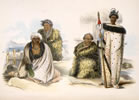Māori- and English-language versions
The meaning of te tiriti (the treaty) in Māori differed from the meaning of the treaty in English. There has been much debate over the differences. At the time it was signed, it is not clear how much notice was taken of the precise wording. The oral discussions before the signings may have mattered more than the written texts.
Most Māori signed the document written in te reo Māori.
Article One
Te reo Māori: rangatira gave the queen ‘te Kawanatanga katoa’ – the governance or government over the land.English: rangatira gave the queen ‘all the rights and powers of sovereignty’ over the land.Article Two
Te reo Māori: confirmed and guaranteed the rangatira ‘te tino rangatiratanga’ – the exercise of chieftainship – over their lands, villages and ‘taonga katoa’ – all treasured things. Māori agreed to give the Crown the right to deal with them over land transactions.English: confirmed and guaranteed to the rangatira ‘exclusive and undisturbed possession of their lands and estates, forests, fisheries, and other properties’. The Crown sought an exclusive right to deal with Māori over land transactions.Article Three
Te reo Māori: The Crown gave an assurance that Māori would have the queen’s protection and all rights accorded British subjects. This was an accurate translation of the English text, although these rights were not defined.
Reasons for signing
In 1840, rangatira Māori decided for or against signing te tiriti on the basis of its Māori text and after weighing various considerations. They wanted regulated settlement and support in controlling settlers and land sales. Trade and the cash income from employment opportunities would bring benefits to Māori communities. The new relationship would also enable them to avoid the intertribal warfare that had escalated in previous decades.
Although rangatira were aware that a colonial administration would require some concessions to allow it to exercise power, they were assured by officials that their own authority was left in place by Article Two of te tiriti (in the Maori-language text). This suggested that authority would be shared between the government and rangatira. This shared authority would be enhanced by the other treaty articles, to Māori advantage.
Reasons for not signing
Some rangatira had no opportunity to sign te tiriti, as there were apparently no treaty meetings in regions such as Taranaki and Wairarapa, and almost none in other areas, such as Hawke’s Bay. Sometimes rangatira were absent, and negotiators were too impatient to await their return.
Although a copy of te tiriti went into the central North Island, Te Arawa and Ngāti Tūwharetoa rangatira refused to sign it. The impact of the European world on these inland tribes was less than on coastal iwi at that time. Rangatira valued their independence and were not prepared to place their mana under that of the British queen. The powerful Waikato rangatira Te Wherowhero also refused to sign, perhaps for this reason.
In districts where intertribal disputes were in progress, rangatira were not prepared to allow British interference. Tāraia (Ngāti Tamaterā and Ngāti Maru) of Thames and Tūpaea (Ngāi Te Rangi) of Tauranga refused to sign the treaty because they wanted to retain full control over their affairs, and settle their own disputes.
Although several powerful rangatira did not sign the treaty, the British Crown was given a considerable mandate for its colonisation plans. However, it was not an overwhelming mandate and was therefore likely to be challenged in the future.


